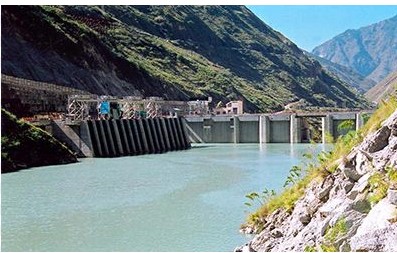Context:
SJVN Inaugurated India’s first multi-purpose Green Hydrogen pilot project at Nathpa Jhakri Hydro Power Station (NJHPS) in Jhakri, Himachal Pradesh.
More on the news
- Satluj Jal Vidyut Nigam (SJVN) Limited inaugurated India’s first Multi-purpose (Combined Heat & Power) Green Hydrogen Pilot Project at SJVN’s 1,500 MW Nathpa Jhakri Hydro Power Station (NJHPS) in Jhakri, Himachal Pradesh.
- The green hydrogen produced from the project will be utilized for the High-Velocity Oxygen Fuel (HVOF) Coating Facility of NJHPS to meet its combustion fuel requirements.
- High Velocity Oxygen Fuel (HVOF) coating: It is a thermal spray coating process, which is used to improve or restore a component’s surface (properties or geometry). This surface engineering technique enables life extension of equipment by increasing erosion and wear resistance, and corrosion protection.
- SJVN also inaugurated 412 MW Rampur Hydro Power Station (Rampur HPS), by remotely operating Unit-2 of Rampur HPS from NJHPS Control Room at Jhakri, Himachal Pradesh.
- Rampur HPS is located on River Satluj in Shimla and Kullu districts of Himachal Pradesh and is a tandem development to Nathpa Jhakri Hydro Power Station.
- Rampur HPS is being successfully operated on a Tandem Operating System with NJHPS.
About Nathpa Jhakri Hydropower Station
Background:

- The foundation stone for Nathpa Jhakri Hydro Electric Project was laid at Jhakri by the then Prime Minister of India Shri Rajiv Gandhi on 13th April 1989.
- A Memorandum of Understanding for the execution of the Nathpa Jhakri project was signed between the Government of India and the Government of Himachal Pradesh in July 1991. The Project has been financed on a 50:50 debt-equity ratio basis.
- Project commissioned in May 2004 and dedicated to the nation by Hon’ble Prime Minister of India Sh. Manmohan Singh on May 28, 2005.
features of NJHPS:
- NJHPS of 1500 MW capacity is the country’s largest hydropower plant.
- A 62.50 m. high Concrete Gravity Dam on River Satluj River at Nathpa to divert 486 cumecs of water through four intakes
- NJHPS will also generate electricity through its fuel cell of 25 kW capacity.
- This project is set to produce 14 kilograms of Green Hydrogen daily during 8 hours of operation.
- The project will produce hydrogen using an alkaline electrolyzer of 20 Nm3/hour capacity, which would be powered by renewable energy supplied from the 1.31 MW Solar Power Plant of SJVN in Wadhal, Shimla.
Satluj Jal Vidyut Nigam (SJVN Limited)
- It is a Mini Ratna, Category-I and Schedule – ‘A’ CPSE under the administrative control of the Ministry of Power, Government of India.
- It was incorporated on May 24, 1988, as a joint venture of the Government of India (GOI) and the Government of Himachal Pradesh (GOHP).
- It is now a listed Company having a shareholders pattern of 55.00% with the Government of India, 26.85% with Government the of Himachal Pradesh, and the rest of 18.15% with the Public.
- SJVN aims to be a 25000 MW company by 2030 and a 50000 MW company by 2040.
Significance
- The project aligned with the National Green Hydrogen Mission (NGHM) of the Government of India, SJVN’s Green Hydrogen Pilot Project is poised (ready to move) to accelerate the development of green hydrogen production infrastructure in the power sector.
- NGHM launched in Jan 2023 aims to decarbonise India to make it energy independent by 2047 and achieve Net Zero by 2070.
- Besides generating power, the green hydrogen will also be used for High Velocity Oxygen Fuel Coating of turbine underwater parts.

